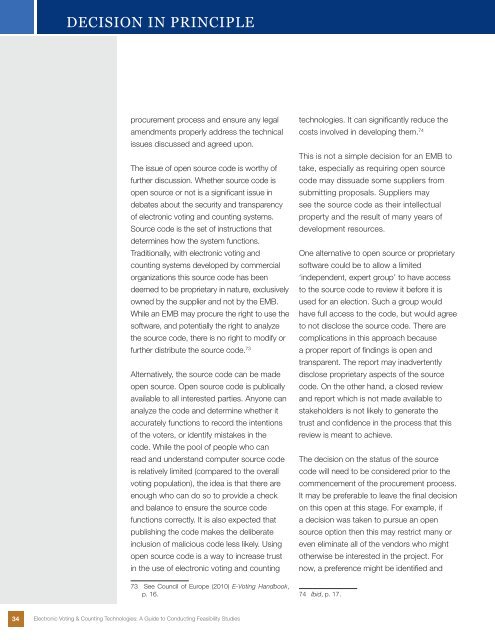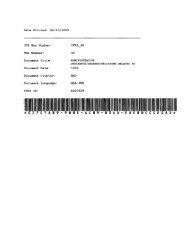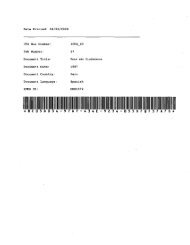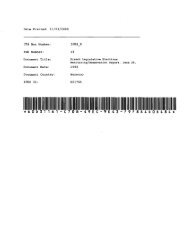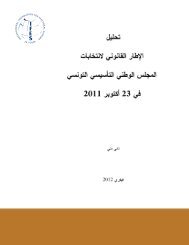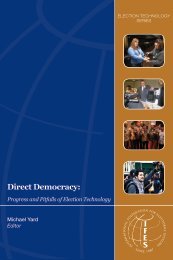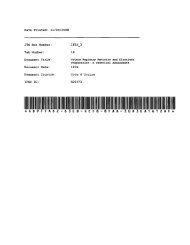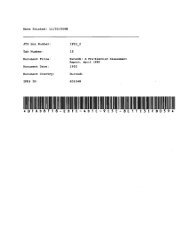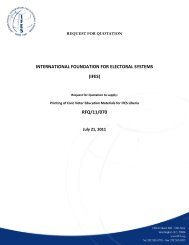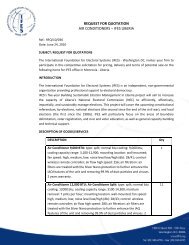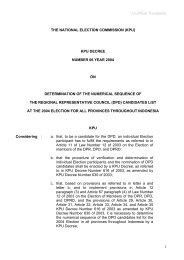Electronic Voting & Counting Technologies - IFES
Electronic Voting & Counting Technologies - IFES
Electronic Voting & Counting Technologies - IFES
- No tags were found...
Create successful ePaper yourself
Turn your PDF publications into a flip-book with our unique Google optimized e-Paper software.
INTERNATIONAL DECISION PRINCIPLEELECTORAL STANDARDSprocurement process and ensure any legalamendments properly address the technicalissues discussed and agreed upon.The issue of open source code is worthy offurther discussion. Whether source code isopen source or not is a significant issue indebates about the security and transparencyof electronic voting and counting systems.Source code is the set of instructions thatdetermines how the system functions.Traditionally, with electronic voting andcounting systems developed by commercialorganizations this source code has beendeemed to be proprietary in nature, exclusivelyowned by the supplier and not by the EMB.While an EMB may procure the right to use thesoftware, and potentially the right to analyzethe source code, there is no right to modify orfurther distribute the source code. 73Alternatively, the source code can be madeopen source. Open source code is publicallyavailable to all interested parties. Anyone cananalyze the code and determine whether itaccurately functions to record the intentionsof the voters, or identify mistakes in thecode. While the pool of people who canread and understand computer source codeis relatively limited (compared to the overallvoting population), the idea is that there areenough who can do so to provide a checkand balance to ensure the source codefunctions correctly. It is also expected thatpublishing the code makes the deliberateinclusion of malicious code less likely. Usingopen source code is a way to increase trustin the use of electronic voting and counting73 See Council of Europe (2010) E-<strong>Voting</strong> Handbook,p. 16.technologies. It can significantly reduce thecosts involved in developing them. 74This is not a simple decision for an EMB totake, especially as requiring open sourcecode may dissuade some suppliers fromsubmitting proposals. Suppliers maysee the source code as their intellectualproperty and the result of many years ofdevelopment resources.One alternative to open source or proprietarysoftware could be to allow a limited‘independent, expert group’ to have accessto the source code to review it before it isused for an election. Such a group wouldhave full access to the code, but would agreeto not disclose the source code. There arecomplications in this approach becausea proper report of findings is open andtransparent. The report may inadvertentlydisclose proprietary aspects of the sourcecode. On the other hand, a closed reviewand report which is not made available tostakeholders is not likely to generate thetrust and confidence in the process that thisreview is meant to achieve.The decision on the status of the sourcecode will need to be considered prior to thecommencement of the procurement process.It may be preferable to leave the final decisionon this open at this stage. For example, ifa decision was taken to pursue an opensource option then this may restrict many oreven eliminate all of the vendors who mightotherwise be interested in the project. Fornow, a preference might be identified and74 Ibid, p. 17.34<strong>Electronic</strong> <strong>Voting</strong> & <strong>Counting</strong> <strong>Technologies</strong>: A Guide to Conducting Feasibility Studies


